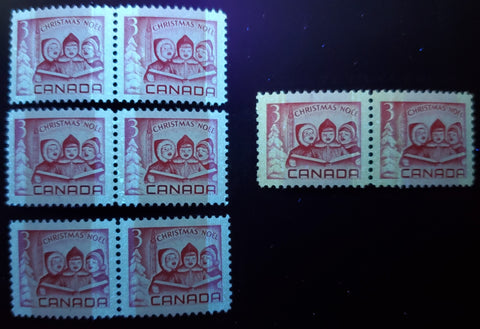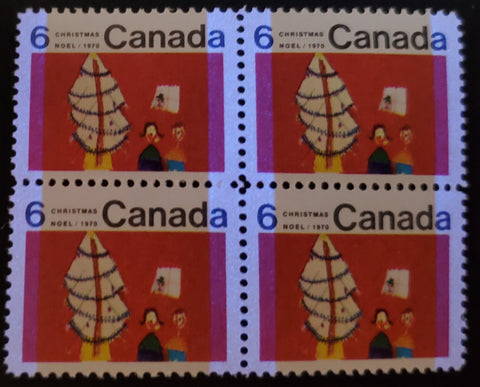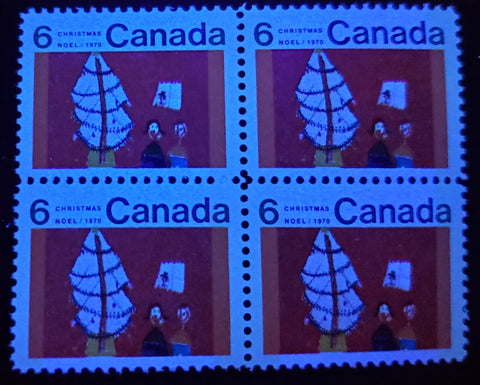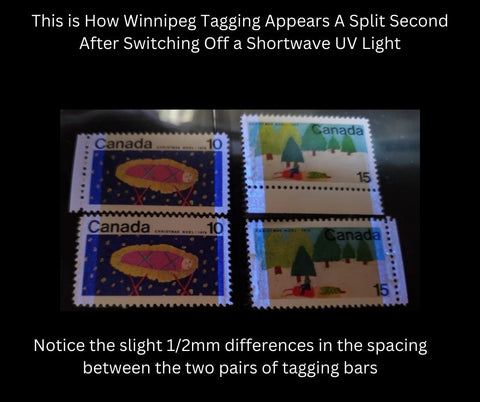Winnipeg tagging was first introduced in 1962 on the Wilding issue, and apart from the difference between 1 bar and 2 bar tagging, very few varieties have been listed in Unitrade with respect to it. In recent years, there has been recognition of the wide and narrow tag bar varieties on some issues, and Adminware has been listing the 1-bar tag errors that result from shifting of the tagging bars meant to be shared between two stamps. However, little else has been written about the tagging.
At least a part of this is because most collectors probably couldn't see these differences, because they were viewing the tagging using a normal black light that emits long-wave ultraviolet light. While the tagging does show up under long-wave UV, it appears only as darker bands and does not glow any particular colour. Also, the afterglow that is supposed to be visible after the lamp is switched off, is not generally visible when the stamps have been viewed with long wave UV light.
We viewed all the commemorative issues from 1964 to 1972 under short-wave ultraviolet light instead. What follows is a comparison of how the tagging appears under both types of light for the early Winnipeg Tagged issues and the later ones, as well as a discussion of the following aspects of the tagging:
- Duration of afterglow, colour of afterglow
- Colour of tagging under shortwave UV when the light is on.
- Tagging bar widths.
- Spacing varieties between tag bars
Appearance Under Long Wave and Short Wave Ultraviolet Light
Early Issues - Shortwave

This picture was taken while the stamps were viewed under short wave UV light and you should be able to see that the colour of the tagging varies from bluish white on the left three pairs to yellowish cream on the right pair. Also you can see very clear differences in the width of the tagging bars.
Later Issues

This picture was taken the split second after the shortwave lamp was switched off and shows the bands appearing their characteristic bluish white colour.

This picture is taken while the light is on and is identical to how the block would appear under long wave UV light. Here the bands appear a light colour, but are completely overshadowed by the HB glow of the paper.
Visibility of the Tagging
The tagging bars of all issues are highly visible on all issues, except the 1972 Christmas issue, which are very difficult to see under the short-wave lamp. Up until the 1968 Christmas issue the tagging glows bluish white while the light is on. From the 1968 Christmas issue to the 1972 Christmas issue, the tagging appears as dark bands under the lamp, with the bluish white colour only being visible as an afterglow after the lamp is switched off.
Duration of Afterglow
The afterglow duration varies very widely from a low of almost nothing to up to 8 seconds. Generally the duration increases as one moves forward it time. Most of the 1964, 1965, 1966 and 1967 issues have a 4 second duration, with a few printings having only a 2 second afterglow. Starting in 1968-1969 the afterglow increases to 5-6 seconds for most issues, and then in 1970-1971 it is between 7-8 seconds for most issues. The 1972 Christmas issue is the major exception to this, with almost no discernable afterglow, given that it fades almost as soon as your eye can process it.
Colour of the Tagging Under Shortwave UV light
The most common colour up to the 1968 Christmas issue is bluish white to a very bright bluish white. There are some printings of some of the 1966 and 1967 Christmas issues that have clearly yellowish to yellowish cream coloured tagging. Starting in 1968 the tagging appears dark brown under the light, and this continues up to the 1971 Christmas issue. The only exceptions in this period are the Manitoba Centennial, United Nations and Expo'70 issue, which again appear bluish white.
Tagging Bar Widths
The tag bars vary between 4 mm and 10 mm for all issues, with the centre bar tags being 4 mm and some bands at the margins of the sheets being 5 mm to 6mm wide. Most 2-bar tags are between 7.5 mm and 10 mm wide.
Spacing Between Tagging Bars and Varieties

While most issues showed some shifting of the tagging bars, most all stamps I looked at showed very consistent spacing between the tagging bars. However, there were some differences of between 1/2 mm to 1 mm on some stamps.
Conclusion
The study of the tagging using shortwave UV light was worthwhile as it did highlight some differences that were previously unknown. There may be others that we haven't yet found, as I only had very limited quantities of material to work with for some issues like the 1970 UN issue. Also, I didn't have a lot of marginal blocks for some issues, so studying the tagging bar widths at the margins was somewhat limited. However the preliminary findings suggest that it will be worthwhile to study Winnipeg tagged material carefully going forward.

